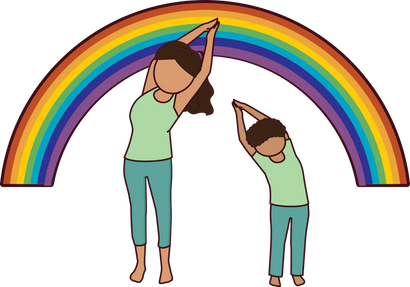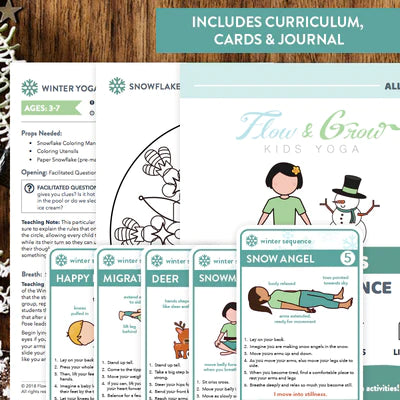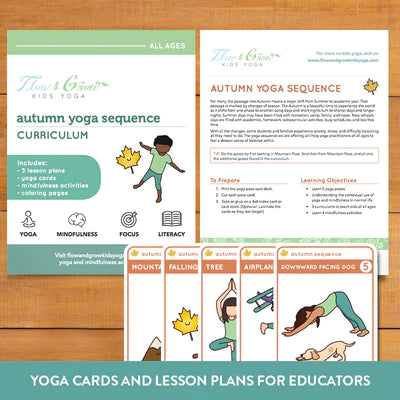Your Cart is Empty
22% off Automatically at checkout when you spend $5 of more!
22% off Automatically at checkout when you spend $5 of more!

Step-by-Step Guide to the Pigeon Yoga Pose
by Kane SEO December 13, 2024 4 min read
The Pigeon Pose is a popular yoga move that stretches the hips, thighs, and lower back. It's great for improving flexibility, opening up the hip area, and relieving tension in the body. If you're new to yoga, this pose might seem tricky, but it can be modified to fit your flexibility and strength. Here's a simple guide to help you practice Pigeon yoga Pose safely and effectively.
Get your copy of the yoga pose cards you see below:120 Yoga Cards for Classrooms
 |

|
Benefits of Pigeon Yoga Pose
Before we get started, here are some reasons why Pigeon yoga Pose is great for your body:
- Opens the hips: It helps stretch tight hip muscles, especially from sitting for long periods.
- Improves flexibility: It stretches your hips, thighs, and lower back.
- Relieves lower back tension: By opening the hips, it reduces tightness in the lower back.
- Reduces stress: Like otheryoga poses, pigeon can help release tension in the body and bring your attention inward. If you do reclined pigeon, where you allow your upper body to rest on the floor, cushion, or you hands, you can also reduce visual stimuli and create a deeper feeling of rest.
- Stimulates digestion: The stretch helps improve digestion.
Preparing for Pigeon Yoga Pose
Before trying Pigeon yoga Pose, warm up your body with some easy stretches to open your hips and stretch your legs:
 |
 |

|
|
- Cat-Cow Pose: This helps improve spinal mobility and prepare you for a resting pose like pigeon.
- Downward-facing dog is great for stretching the hamstrings, calves, and hips and broadening the back body to allow deeper breathing.
- Lunge Pose: Helps stretch your hip flexors.
- Seated Forward Fold: Releases tension in the hamstrings and lower back.
Once you're warmed up, you're ready for Pigeon yoga Pose!
Get your copy of the yoga pose cards you see below:120 Yoga Cards for Classrooms
Step-by-Step Instructions

Step 1: Start in Tabletop Position
Get on your hands and knees, with your wrists directly under your shoulders and knees under your hips. Keep your back straight and engage your core.
Step 2: Bring One Knee Forward
From tabletop, bring your right knee towards your right wrist. Angle your shin so it’s parallel to the front of your mat. Your right foot should be near your left hip.
Step 3: Extend the Left Leg Back
Stretch your left leg straight behind you. Keep your left knee off the floor, with the top of your foot pressing into the mat. Make sure your left thigh is slightly rotating inward to help align your hips.
Step 4: Adjust Your Hips
Make sure your hips are level. If they are not, you may want to try Z sit or figure 4.
Step 5: Lengthen Your Spine
Sit tall, lengthen your spine, and imagine reaching the top of your head toward the ceiling. Keep your chest open and avoid rounding your back.
Step 6: Fold Forward (Optional)
If you feel comfortable, you can fold forward over your front leg. Walk your hands out in front of you and lower your torso. If your forehead doesn’t touch the floor, you can use a block or pillow for support.
Step 7: Breathe and Hold
Hold the pose for 5 to 10 breaths, letting your body relax deeper with each exhale. Stay calm and focused on your breath.
Step 8: Come Out of the Pose
To exit, slowly walk your hands back towards your torso and lift your upper body. Tuck your left toes and bring your left knee back down. You can then return to Tabletop or Child’s Pose to relax.
Step 9: Repeat on the Other Side
Once you’re done with one side, switch legs and repeat the same steps on the other side.
Modifications for Pigeon Pose
If thePigeon yoga Pose feels too intense, here are some ways to make it easier:
- Use props: Place a cushion or yoga block under your hips for extra support.
- Skip the forward fold: Stay upright if folding forward feels too much.
- Reclined Pigeon: Lie on your back and cross one ankle over the opposite knee, gently pressing the knee away for a similar stretch.
- Adjust leg placement: If the front leg feels uncomfortable, angle it slightly for more ease.
Common Mistakes to Avoid
- Arching the lower back: Engage your core to avoid an arch in your lower back. Use a prop if needed.
- Collapsing your chest: Keep your chest open and spine long to avoid strain.
- Forcing the stretch: Only go as deep as feels comfortable. Don’t push yourself too hard.
Conclusion
The Pigeon Pose is a powerful and transformative posture that offers numerous benefits for both the body and mind. InFlow & Grow Kids Yoga, we guide children through this gentle yet effective hip-opening pose, helping them build flexibility and strength. This pose allows for deeper breathing, relaxation, and a sense of emotional release. By following the steps outlined in this guide, kids can practice the Pigeon Pose safely and effectively, gradually increasing their flexibility and mobility while also fostering self-awareness and mindfulness.
Remember to listen to your body and modify the pose as needed. Whether you’re a beginner or advancing in your practice, always approach the pose with kindness and patience toward yourself. By embracing the deep sense of release and relaxation that comes from this beautiful posture, you’ll discover the benefits of flexibility, balance, and inner peace.
Leave a comment
Comments will be approved before showing up.
Also in Kids Yoga Blog

How Social and Emotional Learning and Yoga Help Kids Breathe Through Big Emotions
by Kane SEO April 21, 2025 4 min read

How Social and Emotional Learning and Yoga Help Kids Breathe Through Big Emotions
by Kane SEO April 14, 2025 4 min read
In classrooms and communities around the world, educators and parents alike are placing a growing emphasis onsocial and emotional learning. And for good reason: helping children understand, manage, and express their emotions in healthy ways is just as critical as teaching them to read or do math.

Power of Yoga for Kids: How It Helps Them Grow, Focus, and Thrive
by Kane SEO March 25, 2025 5 min read
In today’s fast-paced world, children are often exposed to stressors from a young age, whether it’s academic pressure, social challenges, or the overwhelming influence of digital devices. This can impact their physical, mental, and emotional well-being.
Ultimate Kids Year of Yoga Bundle
bundlespricey-contentdigital-resourcesearly-childhood-yoga-mindfulnesselementary-yoga-mindfulnesskids-yoga-resourcesmiddle-high-school-yoga-mindfulnessseasonal-yogayoga-cards
Ultimate Kids Year of Yoga Bundle
5 reviews
5.0 / 5.0
(5) 5 total reviews
$45.00
Ultimate Kids Year of Yoga Bundle
5 reviews
5.0 / 5.0
(5) 5 total reviews
$45.00
Kid’s Sun Salutation Yoga Cards
digital-resourcesearly-childhood-yoga-mindfulnesselementary-yoga-mindfulnesskids-yoga-resourcesliteracyunder-15yoga-cards
Kid’s Sun Salutation Yoga Cards
3 reviews
4.33 / 5.0
(3) 3 total reviews
$10.00
Kid’s Sun Salutation Yoga Cards
3 reviews
4.33 / 5.0
(3) 3 total reviews
$10.00
Yamas and Niyamas: Successful Relationships with Self & Others (tweens and teens)
pricey-contentdigital-resourceskids-yoga-resourceslesson-plansmiddle-high-school-yoga-mindfulnessmindfulness
Yamas and Niyamas: Successful Relationships with Self & Others (tweens and teens)
2 reviews
5.0 / 5.0
(2) 2 total reviews
$49.00$55.00
Yamas and Niyamas: Successful Relationships with Self & Others (tweens and teens)
2 reviews
5.0 / 5.0
(2) 2 total reviews
$49.00$55.00















